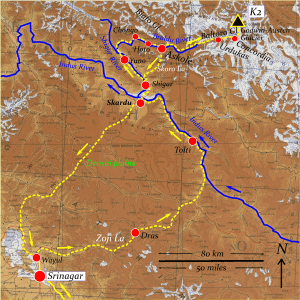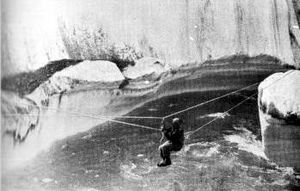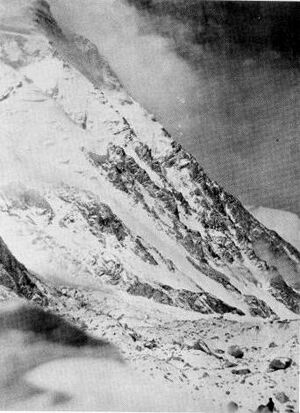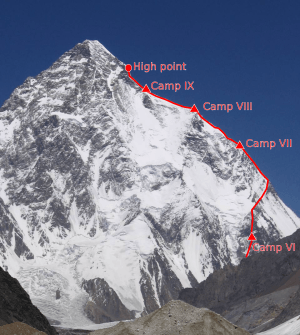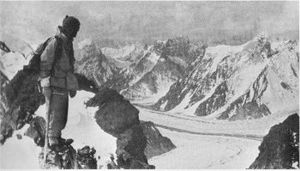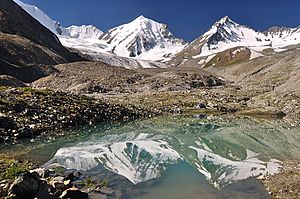1938 American Karakoram expedition to K2 facts for kids
The 1938 American K2 Expedition was the first time American climbers explored K2, the world's second-highest mountain. K2 is 28,251 feet (8,611 m) tall and had never been climbed before. Charlie Houston led a small, friendly team. They wanted to find the best way to reach the top.
The team decided the Abruzzi Ridge was the best path. They climbed well, reaching 24,700 feet (7,500 m) by July 19, 1938. However, they were running low on food. Bad weather, called the monsoon, seemed to be coming. So, Houston and Paul Petzoldt made a final push. They wanted to get as close to the summit as they could. On July 21, they reached about 26,000 feet (7,900 m). The weather was good, and they saw a clear path to the top. They also found a good spot for a higher camp.
The expedition was a big success. No one was seriously hurt. They had explored the Abruzzi Ridge in detail. They found good places for tents that future climbers would use. They also identified the hardest part of the climb: House's Chimney at 22,000 feet (6,700 m). This part was named after Bill House, who led the difficult two-hour climb up the rock face. The team wrote a successful book about their adventure called Five Miles High. The next year, the 1939 American K2 expedition used their findings. That team got very close to the summit, but their trip ended sadly.
Contents
All About K2
What is K2?
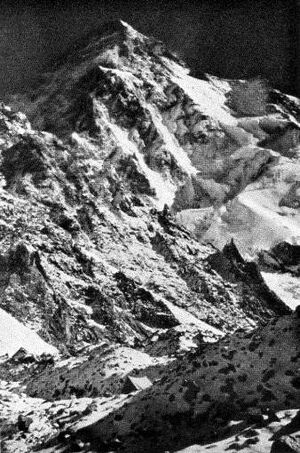
K2 sits on the border between what was then India (now Pakistan) and China. It is 28,251 feet (8,611 m) high. K2 is the tallest peak in the Karakoram mountain range. It is the second-highest mountain in the world.
Explorers first saw K2 in 1856. By 1861, Henry Godwin-Austen reached the Baltoro Glacier. From there, he had a clear view of K2. He saw that the glacier's water flowed into the Indus River. This meant the mountain was in the British Empire at the time. The Karakoram mountains are colder than the Himalayas. They also have more ice and snow.
K2's Climbing History
In 1890, Roberto Lerco explored the K2 area. He reached the base of the mountain. He might have even climbed a short way up. But he did not write much about his trip.
The first serious attempt to climb K2 was in 1902. A group including Aleister Crowley tried to find a way up. They explored routes on both sides of the mountain. They made the most progress on the northeast ridge. But they had to give up. Since then, K2 has been known as a harder mountain to climb than Mount Everest. Every path to its summit is very tough.
In 1909, the Duke of the Abruzzi led an expedition. They reached about 20,510 feet (6,250 m) on the southeast ridge. They decided the mountain was too hard to climb. This path later became known as the Abruzzi Ridge. It is now the most common way to the summit. In 1929, Aimone de Savola-Aosta explored the upper Baltoro Glacier near K2. He was the Duke of the Abruzzi's nephew.
Getting Ready for the 1938 Trip
Planning the K2 Expeditions
At a meeting in 1937, the American Alpine Club (AAC) discussed climbing K2. Charlie Houston and Fritz Wiessner were the main speakers. Wiessner suggested an expedition to be the first to climb K2. Everyone liked the idea. The AAC president asked for permission to go. The British authorities in India approved a plan. They allowed a scouting trip in 1938. If that failed, a full climbing trip would follow in 1939.
Wiessner was expected to lead the first trip. He was probably the best American climber then. But he stepped back and suggested Houston lead instead. Houston had a lot of climbing experience. He had led the first climb of Alaska's Mount Foraker in 1934. He also climbed Nanda Devi in 1936. Nanda Devi was the highest mountain ever climbed at that time. The team's main goal was to scout K2's three main ridges. They hoped to try for the summit if they could.
Meet the Team
The team had several skilled climbers. Bob Bates was Houston's friend from Harvard. He had climbed in Alaska twice. Richard Burdsall had climbed Mount Gongga in China. Bill House had climbed Mount Waddington in Canada with Wiessner. Paul Petzoldt was a very experienced mountain guide. He was also a great rock climber in Wyoming's Tetons. Unlike the others, Petzoldt had not gone to college. Norman Streatfeild was a British army officer. He was based in India. He helped organize the porters and equipment.
What They Took
The team had to figure out what food to bring. They chose 50 pounds (23 kg) of pemmican, a food polar explorers liked. They didn't know then that pemmican was too fatty for high altitudes. They also took hard biscuits that wouldn't get soft. Dried fruit, vegetables, cereal, and powdered milk were also part of their supplies.
Their boots were made of leather with hobnails. They were specially made in England. Climbing ropes were made of manila and hemp, not nylon. Their ice axes had long wooden handles with metal picks. They brought very little special climbing gear. They thought ten pitons (metal spikes) would be enough. Petzoldt liked modern gear. He secretly bought fifty more pitons in Paris because he couldn't afford the trip otherwise.
Journey to K2 Base Camp
The expedition left New York on April 14. They sailed to Bombay in India. They arrived in Rawalpindi on May 9. Then they drove north of Srinagar to Wayul, where the road ended. From there, they trekked 360 miles (580 km) over the Zoji La pass to Skardu. Then they went on to Askole and finally to K2 Base Camp.
In Srinagar, they met six Sherpas they had hired. These Sherpas had traveled from Darjeeling. Sherpas are skilled mountain guides. Each climber, called a "sahib," had a Sherpa. Pasang Kikuli was with Houston. He was also the sirdar (chief Sherpa). Three Kashmiri shikaris (hunters) were hired to manage Base Camp. They included Ahdoo the cook.
They started with fewer than 100 porters and 25 ponies. The ponies could only go as far as Yuno. There, 75 more porters joined them. Local porters were hired for short parts of the journey. At Yuno, the porters refused to work for the pay offered. So, Bates and Streatfeild rafted back to Skardu. They went 28 miles (45 km) down the Shigar and Indus rivers to find more helpful porters.
At Hoto, they had to cross the Braldu River. The bridge was made of woven willow twigs. It was 200-foot (61 m)-deep gorge. They reached Askole on June 3. But Petzoldt became ill with a fever. Houston, who was a doctor, stayed with him. The others went ahead. They climbed the snout of the Baltoro Glacier. Then they reached Urdukas, a grassy spot where local herdsmen graze animals. Houston and Petzoldt caught up with the group there. On June 12, they reached their Base Camp. The porters were paid and told to return in 45 days.
Finding the Best Climbing Paths
The team used maps and photos from the 1909 Duke of the Abruzzi expedition. They wanted to find the best way to the summit.
Duke of the Abruzzi's Discoveries (1909)
The Duke of the Abruzzi's team had a great photographer, Vittorio Sella. His photos showed the mountains well. They helped later explorers. The 1909 team went up the Godwin-Austen Glacier. From their base camp, they explored K2's northeast ridge. They thought it was impossible. So, they tried the southeast ridge, now called the Abruzzi Ridge. Two guides reached about 21,000 feet (6,400 m). But the whole team couldn't make it.
They then went to the western side of K2. They climbed the Savoia Glacier to a spot called Savoia Pass. It was at 21,870 feet (6,670 m). They were stopped again. As a comfort, they climbed high on Chogolisa, reaching about 24,275 feet (7,399 m). This was the highest altitude ever reached at that time. It wasn't beaten until the 1922 British Mount Everest expedition.
The 1938 Scouting Mission
For two weeks in June 1938, the weather was stormy. Bates and Streatfeild went up the Godwin-Austen Glacier. From there, K2's south face and northeast ridge looked impossible. They explored the Savoia Glacier. But they failed three times to reach the Savoia Pass. The path was blocked by deep cracks and ice walls. They had hoped to find a route there. The 1909 survey said the rocks on the northwest ridge were like steps. But on the Abruzzi Ridge, the rocks sloped down. This made climbing hard and finding tent spots difficult.
Near base camp, the Abruzzi Ridge looked very tough. It was a mix of rock, ice, and snow. It was steep for over 8,000 feet (2,400 m) up to a shoulder at about 26,000 feet (7,900 m). Above this, they could see the summit. A hanging glacier threatened both the northeast and Abruzzi ridges. On June 28, Petzoldt and House liked the Abruzzi Ridge. Houston and Burdsall wanted to check the northeast ridge more.
It was hard to find a place for a tent on the Abruzzi Ridge. But on July 2, Petzoldt found a small, hidden flat spot. It was perfect for several tents. This decided their climbing path. This spot became Camp II.
Climbing the Abruzzi Ridge
| Camp Locations on K2 | ||||
|---|---|---|---|---|
| Camp | Height | Camp Set Up |
Where it is | |
| feet | metres | |||
| Base | 16,600 | 5,100 | (June 12) | Godwin-Austen Glacier |
| I | 17,700 | 5,400 | Base of Abruzzi Ridge | |
| II | 19,300 | 5,900 | July 3 | Small flat spot on Ridge |
| III | 20,700 | 6,300 | July 5 | Place with falling rocks |
| IV | 21,500 | 6,600 | July 13 | Below House's Chimney |
| V | 22,000 | 6,700 | July 14 | Top of House's Chimney |
| VI | 23,300 | 7,100 | July 19 | Base of Black Pyramid |
| VII | 24,700 | 7,500 | July 20 | Plateau by ridge |
| High Point | 26,000 | 7,900 | July 21 | (No camp) On the Shoulder |
| Summit | 28,251 | 8,611 | Not reached | |
Climbing Higher on K2
Camp II was set up on July 3. Right away, there was a problem. A rock fell on a can of cooking fuel, spilling it all. Streatfeild led a small group to find supplies left by a French team. Porters had taken the fuel, but Streatfeild found some food cans. Pemba Kitar and the cook, Ahdoo, went to Askole. They needed to get porters to bring firewood. Eight days later, they returned with ten porters carrying a lot of cedarwood. This meant they had enough fuel for the mountain.
While this was happening, supplies were carried up the Ridge. Fixed ropes were placed in tricky spots. Petzoldt's pitons were very helpful. Climbers used a technique of knotting the hemp ropes and pulling themselves up. Pasang Kikuli, Phinsoo, and Tse Tendrup carried most of the loads. They also moved rocks to make flat places for tents. Camp III was in a dangerous spot. Rocks fell 500 feet (150 m) and punched holes in all three tents. Luckily, no one was hurt. Streatfeild, Burdsall, and three Sherpas left to scout other parts of the mountain. Only Pasang Kikuli went higher up.
Camp IV was near an 80 feet (24 m) vertical cliff. On July 14, Bill House climbed this cliff. It took him two and a half hours. They called it House's Chimney. Pitons were soft back then and didn't work well on hard rock. So, at 21,500 feet (6,600 m), House had to free climb without much protection. There was no other way up the ridge. It was the hardest rock climb at such a high altitude at that time. After this, they quickly moved through the Black Pyramid. By July 19, they were above 25,000 feet (7,600 m).
Everyone was together at Camp VI. They had only ten days of fuel and food left. They worried about bad weather stopping their descent. They voted, and Houston and Petzoldt were chosen to climb as high as possible. They thought the climbing was too hard for Sherpas now. So, only the four sahibs would carry supplies to Camp VII. But Pasang Kikuli begged to come, and they agreed.
Houston and Petzoldt reached Camp VII on July 20. Houston thought a summit attempt was impossible. They then found they had no matches. Luckily, Houston had nine matches in his pocket. They carefully prepared them with grease. They lit the stove with the third match. In the morning, three more matches were used for breakfast. On July 21, they headed toward the Shoulder. The snow was knee-deep. Petzoldt was the stronger climber. By 1:00 PM, they reached the flatter Shoulder. They moved to just 900 feet (270 m) below the couloir, later called the Bottleneck.
At that point, Houston could not go higher. They turned back at 4:00 PM. Petzoldt had reached about 26,000 feet (7,900 m). He found a good spot for a tent for a future trip. As it got dark, they returned to their tent. They lit the stove with their last match. On the way down, below Camp III, Pasang Kikuli shouted. He saw a large rock falling towards them. They quickly found cover. He said "snowmen" had warned him to look up.
Back Home and What They Learned
The team returned to Base Camp by July 25. They left the fixed ropes in place. The trek back to Askole took six days. Eleven more days took them to Srinagar. They took a shorter route over the Skoro La pass. They also crossed the Deosai Plains. The snow had cleared since their trip out.
The expedition was small and didn't cost much. But it found the best way to the summit of K2. They climbed the hardest part and returned without serious injuries. It was a well-organized and successful scouting mission. Climber Ed Viesturs called it "a magnificent achievement." The book Five Miles High is seen as one of the best expedition books. It shows how well the team worked together.
Images for kids
-
K2 from Godwin-Austen Glacier (photo Sella 1909)


